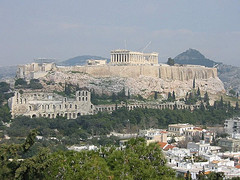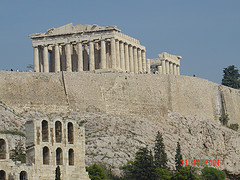Sitting at the foot of the Acropolis, the Theatre saw the birth of Drama as we know it and was the original home of plays still performed today.












 Often known for its prestige as the largest city in Greece, Athens has served as a primary source of silver and marble, a home to the navy in Greece, and a home one of the most well-known temples around the world. This well-known temple, also known as the Parthenon, contains the protector-goddess Athena and sits on top of a large hill commonly known as the Acropolis.
Often known for its prestige as the largest city in Greece, Athens has served as a primary source of silver and marble, a home to the navy in Greece, and a home one of the most well-known temples around the world. This well-known temple, also known as the Parthenon, contains the protector-goddess Athena and sits on top of a large hill commonly known as the Acropolis.
In Greek translation, the title "The Acropolis" means "The Sacred Rock" or "the high city." Although there are many variations of acropolises (acropoli?) in Greece, the Acropolis in Athens is the most well-known. More importantly, many festivals and other events take place at the location, and a variety of myths are centered around this sacred hill. Even today, it still resides as a sign of power and well-being of the Athenian Empire of Ancient Greece.
Why is this location so important? Historically, the Acropolis rock has been present on the Earth since the later part of the Cretaceous period. It sits atop the Attica plateau and consists of several different structures, including the Likavitos and Philopappos hill, the hill of the Nymphs, and the hill of the Pnyx.
The Acropolis also goes by the title of the Cecropia which was derived from the myth of the first Athenian King, a serpent/man who was known as Cecrops. In general, the Acropolis stands at approximately 70 meters in height and is 300 meters in length and 150 meters in width. This structure is also known for it's flat top which is the result of construction efforts that have taken place since the Mycenaean Era. Humans preferred to dwell in this area due to abundant water sources and caves.
In addition, during the Hellenistic and Roman periods, numerous dedications were conducted on The Acropolis by non-Athenian leaders and rulers. After an invasion and partial destruction of this important landmark, a structured wall was built around it in effort to prevent future invasions and devastation. This wall was later named the Beulé Gate.
Ever since the development of this area, human inhabitants have taken an immense interest in colonizing Attica and the land surrounding the Acropolis. Interestingly enough, humans have been suspected of occupying the Acropolis and Attica as early as 6 BC., throughout the Neolithic Era. In fact, habitation of Attica is suspected to have began during the Upper Paleolithic period as hypothesized based on unique artwork and architecture that have arisen. At this time the Acropolis caves and Klepsythra springs were farther occupied as a result of the aforementioned Neolithic period.
In the 13th century, known as the Mycenaean Era, the infamous wall around the Acropolis was built in effort to protect the king and allow him to possess greater control of the surrounding land. Composed of two distinct barricades, this wall also includes a tower to heighten self-defense efforts.
While Athenians have struggled to protect this influential structure, this task has not always been easy nor feasible. In fact, while the Acropolis experience no major forms of destruction during the Mycaeanian era, this was not the case in the years that followed.
According to Athenian folklore, the Acropolis successfully resisted a potentially-devastating attack by the Dorians. However, due to the resulting rule by the Kylons and Pisistratus, many historians predict a power change took place at this time. Another important event that took place at this time was the construction of an elaborate nine-gate wall around the important water spring of Clepsydra. This wall is also commonly known as "Enneaplyon."
Although the Acropolis has always been a place of importance, it was not deemed as an absolute sacred location until the 6th century BC. At this time a new temple was constructed on the northern side of the hill as a dedication to "Athenia Polias." This temple was constructed of limestone and contains various artifacts and documents pertinent to this time period. It is also known as the "Bluebeard Temple" based upon the three-headed serpent with a blue beard that is featured in the temple. Later in the same century an additional temple, known as "Archaois Naos" (Old Temple), was constructed by the Peisistratos. It was under the rule of this specific group of people that the Acropolis flourished.
Since the "Bluebeard Temple" was later destroyed during an attack during the Battle of Marathon, a new temple, the "Older Parthenon" was built as a replacement. This guilding was significantly larger than the original and exemplified a status of grandeur. However, the "Older Parthenon" was never completely finished, because the Persians attacked Attica once more, destroying many of the existing monuments and structures. As a result, the remaining influential artifacts were then buried by the Athenians in local caves and two more walls were built around the area. These newly-constructed walls are known as "The Wall of Themistocles" and "The Wall of Kimon." Many of the buried artifact survived the war and are now known as the infamous collection of "Persian Debris."
 While we hear about the "Golden Ages" of many different cultures, the city of Athens truly prospered during this time. Pericles was responsible for the construction of virtually any religious structure, such as temples, between 460 BC and 430 BC. An ambitious, yet critical man, Pericles took approximately half a century to construct these buildings. Architects, Ictinus and Callicrates, and sculptor, Phidias, also aided in constructing these structures. Some of the most important Athenian buildings, such as the Parthenon, Propylaia, Erechtheion, and temple of Athena Nike, were also built during this period.
While we hear about the "Golden Ages" of many different cultures, the city of Athens truly prospered during this time. Pericles was responsible for the construction of virtually any religious structure, such as temples, between 460 BC and 430 BC. An ambitious, yet critical man, Pericles took approximately half a century to construct these buildings. Architects, Ictinus and Callicrates, and sculptor, Phidias, also aided in constructing these structures. Some of the most important Athenian buildings, such as the Parthenon, Propylaia, Erechtheion, and temple of Athena Nike, were also built during this period.
To the north of the Acropolis stood many temples that were homes to early sects and Olympian gods, while the south side was dedicated to Athena, a goddess, and her various forms, which included Polias, Pallas, Ergane, Parthenos, Promachos, and Nike. Later on, during the Peloponnesian Era, the building of additional structure ceased from approximately 404 BC to 1st Century BC. Building resumed during the 7th Century BC and a small temple was built on the east side. This temple was dedicated to Augustus and Rome. Despite the many foreign and local attacks, this spiritual landmark remained a flourishing and undefeated citadel that was saved from ultimate destruction by secure renovations.
As years passed, the introduction of various religions began to take a toll on the Acropolis. With the introduction of Christianity into this culture, all of the monuments were converted into useful churches and were renames as churches and cathedrals. Interestingly enough, during the medieval area, some of the monuments and structures were even used as headquarters or to house kings and other rulers.As a result of many invasions and wars, the Parthenon and many other important structures were significantly damaged and/or destroyed. During the later part of the 20th century, the Acropolis was excavated as a result of the recognition of its historical significance and delicate nature. Beginning in the 1830's and leading up to this day, the excavation, scientific exploration, and preservation of this area continues. Currently, artifacts and artwork that have been found can be seen at the Acropolis Museum.








